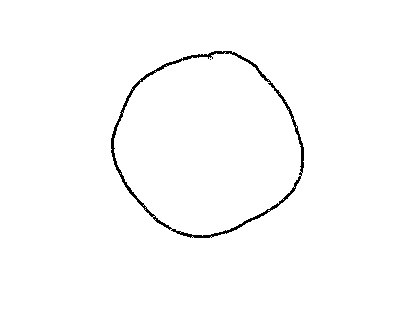Circle
A circle is a closed curve on a plane, which is equidistant from its center. A circle should be distinguished from the closely related concept of a loop, or an . To emphasize the distinction from loops, a circle is sometimes called a rigid circle.
Circles are first-level concepts, meaning that they refer directly to percepts.
Circles are one of the central concepts objects of classical geometry.
Examples
Circles

An example of circle can be seen in figure (1).[note 1]
The letter O is a circle.
Non-circles
The letter Ω is not a circle, because it is not a closed curve.
The number 0 is not a circle, because it is not equidistant from its center.
The traditional concept
In standard mathematics, a circle means a perfect circle. A perfect circle is like a circle, except that it is supposed to lie in a completely flat and infinitely thin plane, the curve of the circle is supposed to have no width, and the distance from the circle to its center is supposed to be completely uniform.
Although standard mathematicians commonly describe things like figure (1) as circles (because it's practical to do so!!), if they are being careful then they will say figure (1) is technically not a circle, but rather a worldly representation of a circle. It is supposed to be imperfect because it has nonzero thickness, and because its distance from its center is not uniform.
By contrast, Objective Mathematics says that figure (1) literally is a circle.[note 1] Furthermore, Objective Mathematics would not say, as an absolute, that figure (1) is "imperfect." To be imperfect is to contain errors. An error presupposes a purposes a purpose or goal, but there is no purpose or goal that is intrinsic to the circle. There is no absolute sense in which uniform circle contains fewer errors than a nonuniform circle; neither can be said to contain errors intrinsically; each simply is what it is. It is only when we plan to use a circle towards some end, that we may say of it that it is perfect or imperfect.
Notes
- ↑ 1.0 1.1 Whether or not figure (1) is deemed a circle depends on context. In our present context, where we are learning about math concepts, it is reasonable to identify it as a circle. If the context was that we were in the beginning stages of drawing a sketch of the moon, it would also be reasonable to identify it as a circle. If the context was that we were designing the blueprint for a precision scientific instrument, it would not be reasonable to identify it as a circle.
